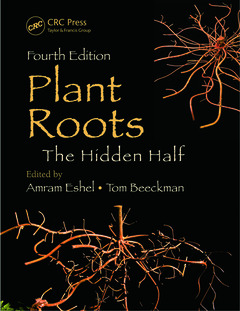Plant Roots (4th Ed.) The Hidden Half, Fourth Edition
Coordonnateurs : Eshel Amram, Beeckman Tom

The decade since the publication of the third edition of this volume has been an era of great progress in biology in general and the plant sciences in particular. This is especially true with the advancements brought on by the sequencing of whole genomes of model organisms and the development of "omics" techniques. This fourth edition of Plant Roots: The Hidden Half reflects these developments that have transformed not only the field of biology, but also the many facets of root science.
Highlights of this new edition include:
- The basics of root research and their evolution and role in the global context of soil development and atmosphere composition
- New understandings about roots gained in the post-genomic era, for example, how the development of roots became possible, and the genetic basis required for this to occur
- The mechanisms that determine root structure, with chapters on cellular patterning, lateral root and vascular development, the molecular basis of adventitious roots, and other topics
- Plant hormone action and signaling pathways that control root development, including new chapters on strigolactones and brassinosteroids
- Soil resource acquisition from agricultural and ecological perspectives
- Root response to stress, with chapters that address the impact of the genomic revolution on this topic
- Root-rhizosphere interactions, from beneficial microorganisms to detrimental nematodes
- Modern research techniques for the field and the lab
Each chapter not only presents a clear summation of the topic under discussion, but also includes a vision of what is to be expected in the years to come. The wide coverage of themes in this volume continues the tradition that makes this work recognized as a fundamental source of information for root scientists at all levels.
The Evolution and Genomics of Roots. The Origin of Roots. Arabidopsis Root. Root Structure. Cellular Patterning of the Root Meristem. Cellular Patterning in the Root Epidermis. Structure and Function of Three Suberized Cell Layers. Lateral Root Development. Vascular Development in Arabidopsis. Roots. Secondary Growth of Tree Roots. Rice: A Model Plant to Decipher the Hidden Origin of Adventitious Roots. Genetic Analysis of Maize Root Development. Molecular Mechanisms Involved in Adventitious Root Formation. Regulation of Root Growth. Auxin Signaling in Primary Roots. Role of Gibberellins in Root Growth. Molecular Basis of Cytokinin Action during Root Development. Ethylene Regulates Root Growth and Development. Abscisic Acid in Root Growth and Development. Brassinosteroid Signaling in Root Development. Role of Strigolactones in Root Development and Communication. Root Gravitropism. Calcium: From Root Macronutrient to Mechanical Signal. Soil Resource Acquisition. Root-Based Solutions to Increasing Crop Productivity. Root Architecture and Resource Acquisition. Root pH Regulation. Root Water Uptake and Water Flow in the Soil–Root Domain. Inorganic Nitrogen Acquisition and Signaling. Nutrient Uptake and Root System Architecture Modeling. Global Change and Root Lifespan. Developmental Adaptations in Roots of Desert Plants with Special Emphasis on Cacti. Root Systems of Woody Plants. Roots as a Source of Food. Root Response to Stress. Temperature Effects on Root Growth. Flooding Tolerance Mechanisms in Roots. Plant Roots under Aluminum Stress. Root Responses to Trace Metallic Elements. Maintaining Root Growth in Drying Soil. Effects of Salinity on Root Growth. Soil Mechanical Resistance and Root Growth and Function. Root–Rhizosphere Interactions. Fungal Root Endophytes. Molecular Physiology of Tree Ectomycorrhizal Interactions. Mycorrhizae—Rhizosphere Determinants of Plant Communities. Response of Soybean Roots to Soybean Cyst Nematode at the Molecular Levell. Modern Research Techniques. Minirhizotron Techniques. Noninvasive Tools for Measuring Metabolism and Biophysical Analyte Transport at the Root–Rhizosphere Interface. Index.
Amram Eshel was born and raised in Israel. He received his degrees from Tel Aviv University, where he was a member of the academic staff from 1980 until his retirement in 2012. During this time, he held short visiting appointments at Ohio Agricultural Research Center in Wooster, Ohio; Michigan State University; The Pennsylvania State University; CNRS at Gif-Sur-Yvette; and University of Western Australia. His main research interests are in the area of plant physiological ecology, especially as related to mineral nutrition and water relations. He is the manager of the Sarah Racine Root Research Laboratory at Tel Aviv University.
Tom Beeckman studied botany at Ghent University in Belgium and, after performing postdoctoral research at the Molecular Genetics Department, became group leader of the Root Development Group at the Flanders Institute of Biotechnology (VIB) in 2001. In 2007, he became a professor at Ghent University, teaching plant developmental biology. He has devoted a considerable part of his research to understanding how cell division is integrated into plant developmental processes, especially during the branching of roots.
Date de parution : 04-2013
21.9x27.6 cm
Thèmes de Plant Roots :
Mots-clés :
Lateral Roots; Auxin Signaling; lateral; Root System Architecture; growth; Lateral Root Initiation; system; Root Growth; tip; Lateral Root Primordia; hidden; Elongation Zone; half; Adventitious Root Formation; hair; Arabidopsis Root; auxin; Root Elongation; transport; Root Meristem; formation; Pericycle Cells; Lateral Root Formation; Root Hair; Auxin Transport; Cytokinin Signaling; Auxin Response; LRC; Casparian Bands; Root Apical Meristem; Root Stem Cell Niche; Seminal Roots; Rooting Systems; Suberin Lamellae; Root Tip



